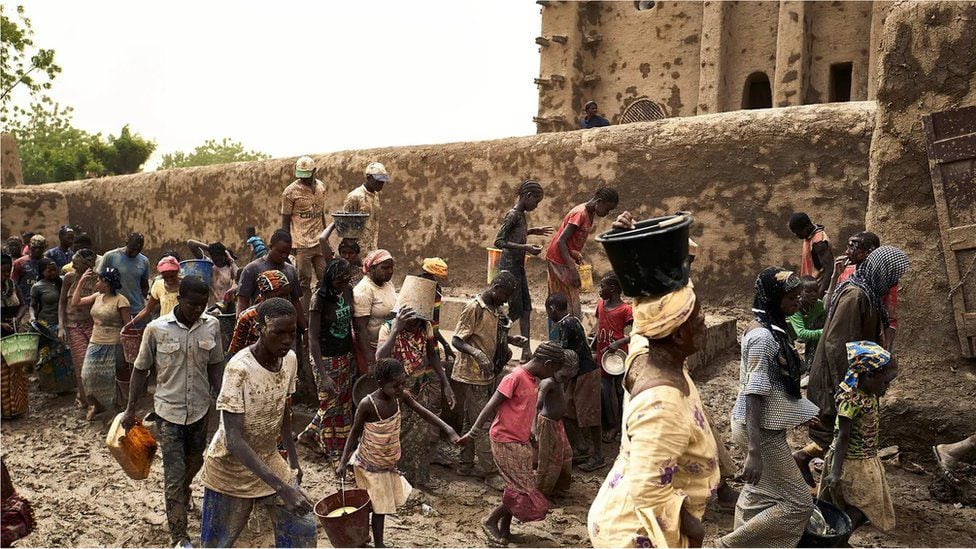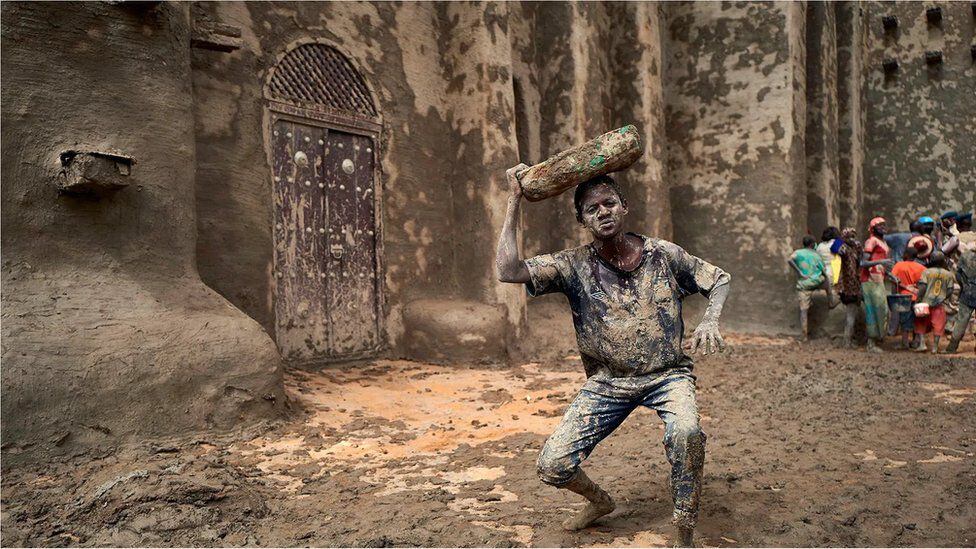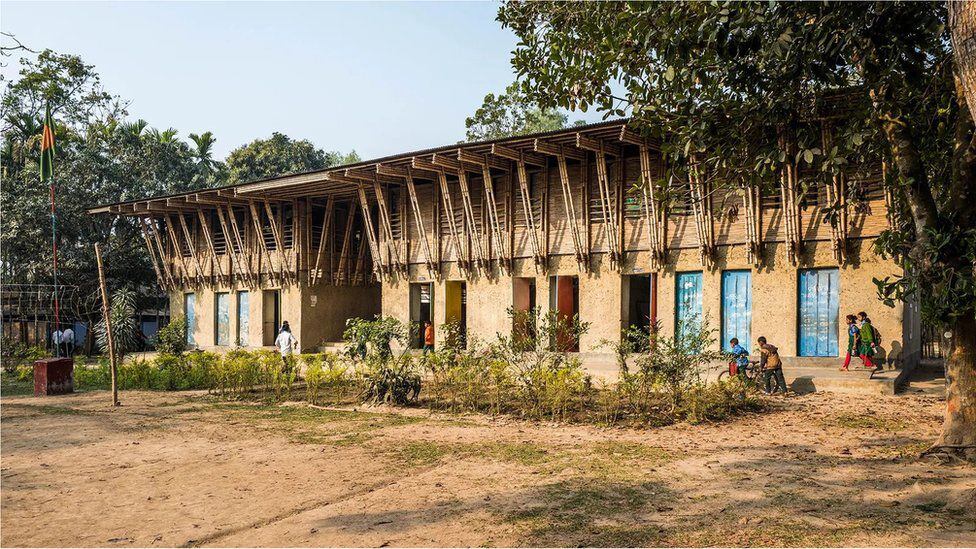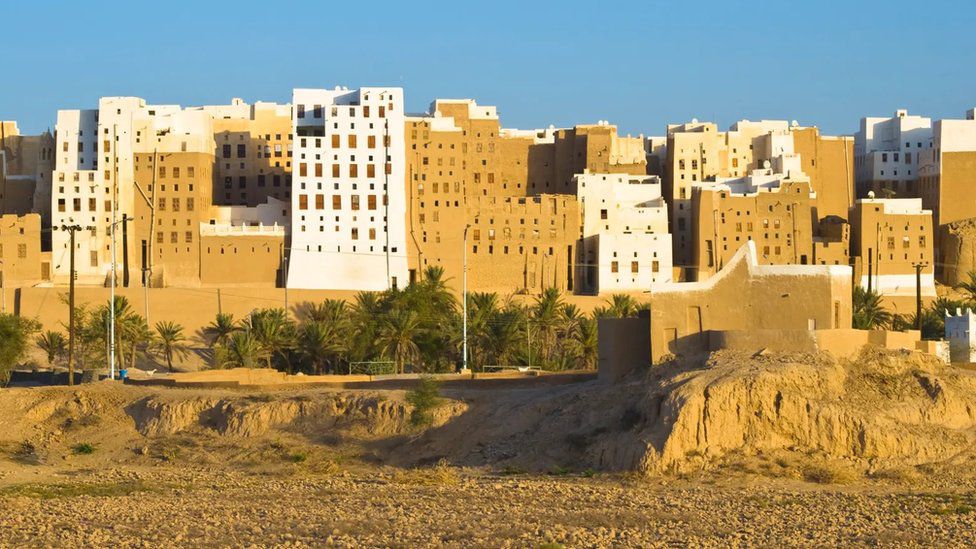In the old walled city of Sana’a, the capital of Yementhe mud skyscrapers rise into the sky.
The imposing structures are built entirely with rammed earth and decorated with striking geometric patterns. The earthen buildings blend with the nearby ocher-colored mountains.
Sana’a’s mud architecture is so unique that the city has been recognized as World Heritage by Unesco.
“As an outstanding example of a homogeneous architectural ensemble that reflects the spatial characteristics of the early years of Islam, the city in its landscape has an extraordinary artistic and pictorial quality,” Unesco writes in its description of Sana’a. “The buildings demonstrate exceptional craftsmanship in the use of local materials and techniques.”
Though the buildings in Sanaa are thousands of years oldremain “massively contemporary,” says Salma Samar Damluji, co-founder of the Daw’an Mud Brick Architecture Foundation in Yemen.
The old structures are still inhabited today and most remain private residences.
Damluji says it’s easy to see why these mud buildings haven’t lost their appeal: they are well insulated, sustainable and extremely adaptable for modern use. “It is the architecture of the future,” she considers.
Architects around the world are reviving earthen building as they seek to build sustainable buildings that can withstand extreme weather events such as flash floods and intense heat.
Could this ancient form of architecture influence the design of our future homes and cities? Could this back-to-basics technique offer a major solution to the climate crisis?
The climate problem of construction
The construction industry represents the 38% of global carbon dioxide emissions.
The construction sector has an important role to play if the world is to meet its goal of reaching net zero by 2050 and keeping global temperature rise below the critical 1.5°C threshold.
Swapping concrete for less polluting materials is critical to achieving our climate goals, scientists warn.
Concrete construction accounts for around 7% of global CO2 emissions, substantially more than the aviation industry, which is responsible for 2.5% of emissions. Every year, 4 billion tons of cement, the key component of concrete, are produced worldwide.
“We can no longer live in these concrete jungles,” says Damluji. “We have to take the environment and biodiversity into account. We cannot build in isolation.”
the mud could be the perfect sustainable alternative to concrete, according to the expert. Building with clay has a very low impact on the environment, and the material itself is fully recyclable, she says.
Reviving an ancient tradition
The city of djenne It is located in the Niger Delta region of central Mali. Founded in the year 800 AD. C., it became an important meeting place for traders traveling from the Sahara and Sudan.
Djenné is known for its magnificent earthen architecture, especially its Great Mosque, which is the largest mud building in the world, standing almost 20 meters high and built on a 91-meter long platform.
Every year, the residents of Djenné come together to repair and restore the mosque, overseen by a guild of high-level masons.

These master builders are revered for their expertise and artistry in Malian society, says Trevor Marchand, Emeritus Professor of Social Anthropology at London’s School of Oriental and African Studies.
“Master builders are renowned for their supernatural powers to bring elements of protection to buildings and the people who live there,” says Marchand.
Djenné’s clay architecture is constantly changing as residents rebuild, repair, and refurbish their homes.
“Clay is very malleable and responds to demographic changes in a home,” he points out, since if the family grows, buildings can easily be added to the house and if it shrinks, the buildings break down and return to earth.
Sustainable construction
The ancient construction practice is inspiring modern architects, such as Serbian Dragana Kojičić, who specializes in raw earth construction.
“Our ancestors they were very smart and very practical: they used what they had around them,” says Kojičić. “The earth was everywhere and could be used for everything: walls, floors, ceilings, stoves and even roofs.”
Kojičić restores and builds earthen houses throughout Serbia, reviving ancient construction methods.
“Mud is contagious, it’s love at first touch,” she says. You don’t need to wear any protective gear when handling the material, she adds. “With the land, you can only play.”

Anna Heringer, an Austrian architect, who creates buildings using natural materials like clay and bamboo, agrees: “It’s a wonderful feeling to touch the earth,” she says.
“You don’t need any tools to build with it, you just use your hands.”
Heringer has been working with clay for almost 20 years and has designed many notable clay buildings, including the METI craft school in Rudrapur, Bangladesh, for which he received the Aga Khan award for architecture in 2007.
“Mud is a very inclusive material; poor and rich can build with it“, He says.
The METI craft school was built entirely with local materials, such as mud, straw and bambooand built by a team of masons, craftsmen and the local students themselves.
“Mud is the champion of sustainable construction of the future,” says Heringer. “It’s the only material that we can recycle as many times as we want, without using energy.”
“It actually gets better the more you use it.” It’s a bit like dough, Heringer says: As you work with it, the material changes and responds.

But the use of mud for construction must be done sustainably and it should not reduce the availability of land for crops, Marchand says. “It can be a solution, but only on a certain scale,” she warns.
Healthy and resilient buildings
One of the best qualities of mud buildings is that they are warm in winter and cool in summer, say the architects.
Mud walls have a high thermal mass, which means they absorb heat slowly and store it, preventing the house from getting too hot.
“Adobe walls (mud and straw mass) collect heat during the day from solar radiation and release it at night. The temperature never fluctuates, it is always at a comfortable levelsays Pamela Jerome, an American architect.
This reduces the need for air conditioning units, which consume large amounts of electricity and contain refrigerants that are potent greenhouse gas emissions.
“Compared to buildings constructed of corrugated concrete or metal, adobe buildings maintain relatively stable interior temperatures over a 24-hour period and therefore provide residents with far superior thermal comfort,” says Marchand.
“An added bonus is that the thick adobe walls also reduce noise levels from outside or next door.”

The breathable nature of mud has other benefits as well. The clay is porous and allows moisture to enter the house, improving indoor air quality.
“They are healthy buildings that breathe the same way we breathe and have skins that adapt to heat and cold,” says Damluji.
“The way they are built refers, even in proportion, to the human body.”
Clay structures are also incredibly strong and resistant to extreme weathersuch as heat waves, floods and droughts, which scientists say will become more frequent and intense as temperatures continue to rise.
They can also withstand extreme events like earthquakes and high winds “due to their structure’s ability to distribute the load it faces across its surface, unlike concrete or cement,” says Damluji.
But the resistance of mud buildings to earthquakes it depends on the intensity of the seismic waves and the soil they are built on, says Jerome.
Mud buildings “are also protected from seasonal rains and flash floods due to the moisture-proof and protective external coating used in several layers of cladding and plaster of refined mud, ash and lime,” says Damluji.
According to Jerome, the impact of flooding on mud buildings varies, depending on whether they are built in a floodplain and have solid foundations.
But today architects say: people who want to live in a modern and comfortable house should consider one made of clay.
Source: Elcomercio
I, Ronald Payne, am a journalist and author who dedicated his life to telling the stories that need to be said. I have over 7 years of experience as a reporter and editor, covering everything from politics to business to crime.

:quality(75)/cloudfront-us-east-1.images.arcpublishing.com/elcomercio/GE3DCMJNGEYS2MJSKQYDAORRGY.jpg)

:quality(75)/cloudfront-us-east-1.images.arcpublishing.com/elcomercio/GLHJWAKRT5EGXM7Z5EG4QYL4KM.jpg)



